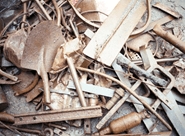Steel Mills

Schnitzer Steel Notes Lower Scrap Pricing and Demand
Written by Sandy Williams
April 3, 2020
Schnitzer Steel Industries, a metals recycler and long products producer, posted revenue of $439 million for the second quarter of FY 2020. Net income was $4.5 million for the quarter, improving from a $7 million loss in Q1 but down significantly from income of $13 million in Q2 2019.
Autos and Metals Recycling achieved operating income of $19 million or $23 per ferrous ton, up from a $2 million loss in the first quarter.
Long products producer Cascade Steel and Scrap posted operating income in line with the previous quarter of $4 million despite lower finished steel prices, higher scrap input costs and a planned maintenance outage. Sales volume increased 37 percent year-over-year due to robust construction demand in West Coast markets and mild winter weather.
Ferrous scrap prices rose during the first two months of the quarter, dipping in February and falling significantly after the quarter’s end for both export and domestic pricing. About two-thirds of Schnitzer’s ferrous products were exported during Q2. “Since the end of the quarter, however, both export and domestic prices have fallen significantly as the auto, oil and gas, construction and manufacturing sectors have slowed down in response to COVID-19,” said Chairman and CEO Tamara Lundgren. “And while we continue to see inquiries for export ferrous shipments on both the East and West Coast, there is a risk that temporary or extended disruptions at destination ports may delay shipping activity.”
“Despite the current volatility, however, the long-term drivers of scrap demand remain intact due to the greater emphasis on recycling, the continued growth in global EAF steelmaking capacity and the increased metal intensity of lower carbon-based economies,” she added.
CFO Richard Peach commented on changes in the non-ferrous market. “The structural changes in the market for recycled non-ferrous products have included Chinese tariffs and increasingly restrictive quotas for Chinese scrap importers. Recently, China announced the removal of tariffs on certain metal scrap imports from the U.S. China has also developed new quality standards for imported scrap. Although uncertainty remains, we understand these new standards will be implemented this year on July 1.Thereafter, we understand non-ferrous products that meet the new definition of raw material and comply with the new quality standards may be eligible for import into China without quota limits.”
Schnitzer Steel Industries is considered an essential business during the COVID-19 crisis and operations have continued with infection control measures implemented at all sites along with some reduced operating hours.
“In light of softening demand and lower supply flows, we’ve reduced operating hours at some of our sites and have also reduced other variable costs associated with lower volumes,” said Lundgren. ”Right now, none of us can say when the pandemic will be over or what additional adjustments may be required. However, the actions that we’ve taken over the past several years have prepared us to move quickly and effectively as the situation requires.”
A number of non-ferrous technology projects at Schnitzer facilities are being delayed due to impacts of the virus on permitting, equipment delivery and outside contractors. As a result, capex has been reduced by $35 million for fiscal 2020 and pushed into 2021. Peach said the company is still expecting to complete the projects by the first half of fiscal 2021.
Commenting on material handling and operations in Asia, Lundgren said, “We are seeing that export demand is weaker, but there continue to be inquiries from customers across our major markets. And most of the people that we are speaking to today want to maintain operations, even if they’re at a reduced level, because they want to be able to restart operations quickly when the pandemic is past us. And the ports that we’re shipping to are still operational, although discharge maybe slower due to reduced personnel. So, as I mentioned before, if supply flows are down, we’re seeing export demand continue. But I think everything is at a bit of a slower pace, a little lower levels and a little bit being executed more slowly.”
During the remainder of FY 2020, Schnitzer Steel will transition from a multi-divisional organization to an integrated one that will begin reporting financial results as a single segment commencing with the first quarter of 2021.
“The rapidly evolving environment that we are in today presents unique and unprecedented challenges,” said Lundgren. “It’s worth noting, however, that we are a company that was founded in 1906, and we’ve experienced downturns and volatility from the Great Depression to the Great Recession. There’s a legacy at our company of facing challenges head on and navigating through the toughest of times.”

Sandy Williams
Read more from Sandy WilliamsLatest in Steel Mills

Cliffs idles Steelton, Riverdale, and Conshohocken operations
Cliffs has idled facilities in Riverdale, Ill., and Conshohocken and Steelton, Pa.

Radius loss narrows, volumes climb in ‘healthy’ West Coast market
Stronger steel demand in the Western US, rising scrap flows, and improved rolling mill utilization drove sequential gains for Portland, Ore.-based Radius Recycling.

AISI: Raw steel production backs off multi-year high
US raw steel output edged lower last week after hitting a multi-year high in mid-June, according to the American Iron and Steel Institute (AISI).

Private equity firm Atlas Holdings to acquire Evraz North America
Atlas Holdings said it has signed a definitive agreement to acquire Evraz North America (Evraz NA). The Greenwich, Conn.-based private equity firm said it expects the deal for the Chicago-based steelmaker to close in the second quarter of 2025 subject to various closing condition.

Granite City Works must remain open and other terms of the Nippon-USS deal
SEC documents also name Trump specifically as having veto power certain decisions are part of the “Golden Share” provision.
